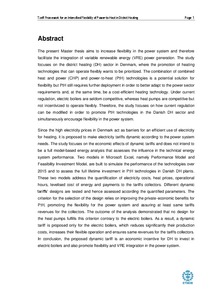Mostra el registre d'ítem simple
Tariff framework for an intensified flexibility of power-to-heat in district heating
| dc.contributor | Skytte, Klaus |
| dc.contributor.author | Blasco Claramunt, Mireia |
| dc.date.accessioned | 2017-11-22T16:50:41Z |
| dc.date.available | 2017-11-22T16:50:41Z |
| dc.date.issued | 2016-11 |
| dc.identifier.uri | http://hdl.handle.net/2117/111087 |
| dc.description.abstract | The present Master thesis aims to increase flexibility in the power system and therefore facilitate the integration of variable renewable energy (VRE) power generation. The study focuses on the district heating (DH) sector in Denmark, where the promotion of heating technologies that can operate flexibly wants to be prioritized. The combination of combined heat and power (CHP) and power-to-heat (PtH) technologies is a potential solution for flexibility but PtH still requires further deployment in order to better adapt to the power sector requirements and, at the same time, be a cost-efficient heating technology. Under current regulation, electric boilers are seldom competitive, whereas heat pumps are competitive but not incentivized to operate flexibly. Therefore, the study focuses on how current regulation can be modified in order to promote PtH technologies in the Danish DH sector and simultaneously encourage flexibility in the power system. Since the high electricity prices in Denmark act as barriers for an efficient use of electricity for heating, it is proposed to make electricity tariffs dynamic according to the power system needs. The study focuses on the economic effects of dynamic tariffs and does not intend to be a full model-based energy analysis that assesses the influence in the technical energy system performance. Two models in Microsoft Excel, namely Performance Model and Feasibility Investment Model, are built to simulate the performance of the technologies over 2015 and to assess the full lifetime investment in PtH technologies in Danish DH plants. These two models address the quantification of electricity costs, heat prices, operational hours, levelised cost of energy and payments to the tariffs collectors. Different dynamic tariffs’ designs are tested and hence assessed according the quantified parameters. The criterion for the selection of the design relies on improving the private-economic benefits for PtH, promoting the flexibility for the power system and assuring at least same tariffs revenues for the collectors. The outcome of the analysis demonstrated that no design for the heat pumps fulfills this criterion contrary to the electric boilers. As a result, a dynamic tariff is proposed only for the electric boilers, which reduces significantly their production costs, increases their flexible operation and ensures same revenues for the tariffs collectors. In conclusion, the proposed dynamic tariff is an economic incentive for DH to invest in electric boilers and also promote flexibility and VRE integration in the power system. |
| dc.language.iso | eng |
| dc.publisher | Universitat Politècnica de Catalunya |
| dc.rights | Attribution-NonCommercial-NoDerivs 3.0 Spain |
| dc.rights.uri | http://creativecommons.org/licenses/by-nc-nd/3.0/es/ |
| dc.subject | Àrees temàtiques de la UPC::Energies::Recursos energètics renovables |
| dc.subject.lcsh | Renewable energy |
| dc.title | Tariff framework for an intensified flexibility of power-to-heat in district heating |
| dc.type | Master thesis |
| dc.subject.lemac | Energies renovables |
| dc.rights.access | Open Access |
| dc.audience.educationlevel | Màster |
| dc.audience.mediator | Escola Tècnica Superior d'Enginyeria Industrial de Barcelona |
| dc.audience.degree | MÀSTER UNIVERSITARI EN ENGINYERIA INDUSTRIAL (Pla 2014) |


